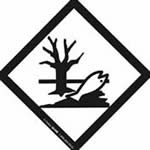| March 27,2015 HAZMAT ROB |
|
 |
|
A recent seminar attendee asked when is a material a marine pollutant, and when is it not a marine pollutant, even though the containers may be marked with the marine pollutant mark? In transportation, the answer depends on who has classified the material, what the size of each container is, and whether it is being shipped by land or sea. |
|
The definition of “Marine Pollutant” in 49 CFR Section 171.8 states that a marine pollutant is a material listed in Appendix B to the 172.101 Hazardous Material Table, and when in a solution or mixture of one or more marine pollutants, is packaged in a concentration which equals or exceeds 10% by weight of the mixture for materials in Appendix B or 1% for materials identified in Appendix B as severe marine pollutants. That seems pretty straightforward, until you take a deeper look. |
|
Who decided the material is a marine pollutant? What if, for example, the material was classified in France under the International Maritime Dangerous Goods Code (IMDG Code)? The IMDG Code makes it clear that if the material is not listed and the shipper can not rule the material out by a “bridging principle,” such as dilution, previously tested mixtures or a “summation method” (where concentrations of classified ingredients and multiplication factors can be used to base the degree of toxicity), then the material must be tested using the IMDG Code’s marine pollutant (aquatic environmental) tests. |
|
Does this mean that a marine pollutant, classified based on the IMDG tests, could be below the DOT percentages? Yes. So, if the international marine pollutant percentages were less than the 1% for severe marine pollutants (SMP) and 10% for marine pollutants (MP), and the material met no other DOT hazard class definition, that material could be re-shipped domestically as unregulated? Yes, again. |
|
There is another consideration. How large is each container? In 171.4(c) Marine Pollutants, there is an exception which states “except when all or part of the transportation is by vessel the requirements in this subchapter specific to marine pollutants do not apply to non-bulk packagings transported by motor vehicle, rail car or aircraft.” |
|
So domestically, if a container of a marine pollutant is non-bulk (less than 119 gallons or 882 pounds) and shipped by ground, it would not be regulated as a marine pollutant, even if the container had 1% of SMP or 10% of MP. However, when shipping the same material in bulk containers by ground, air or water, or in nonbulk containers by water, it would be fully regulated as a DOT marine pollutant. |
|
If your material is in non-bulk containers, and not shipped by vessel (water), it would not matter if it met the international (IMO) or domestic (DOT) definition of a marine pollutant. If the material met no other hazard class definition under 173.2, it would not be regulated domestically as “UN3082 or UN3077, Environmentally Hazardous Substance Liquid or Solid, N.O.S., Class 9, Packing Group III, Marine Pollutant,” or even considered a hazardous material by DOT. |
|
The next question is, if a container is marked as a marine pollutant under the IMDG Code based on the tests, but did not meet the DOT definition of a marine pollutant by percentages, could it still be shipped as a marine pollutant? Yes. In Appendix B to the 172.101 Hazardous Material Table, it says if the material is not listed in the appendix and meets the criteria of a marine pollutant under the IMDG Code, the material “may” be transported as a marine pollutant according to the applicable requirements of the HMR. |
|
If this has only confused you, then give us a call or drop us an email with your questions and we will gladly help. |
- Comment
- Reblog
-
Subscribe
Subscribed
Already have a WordPress.com account? Log in now.
